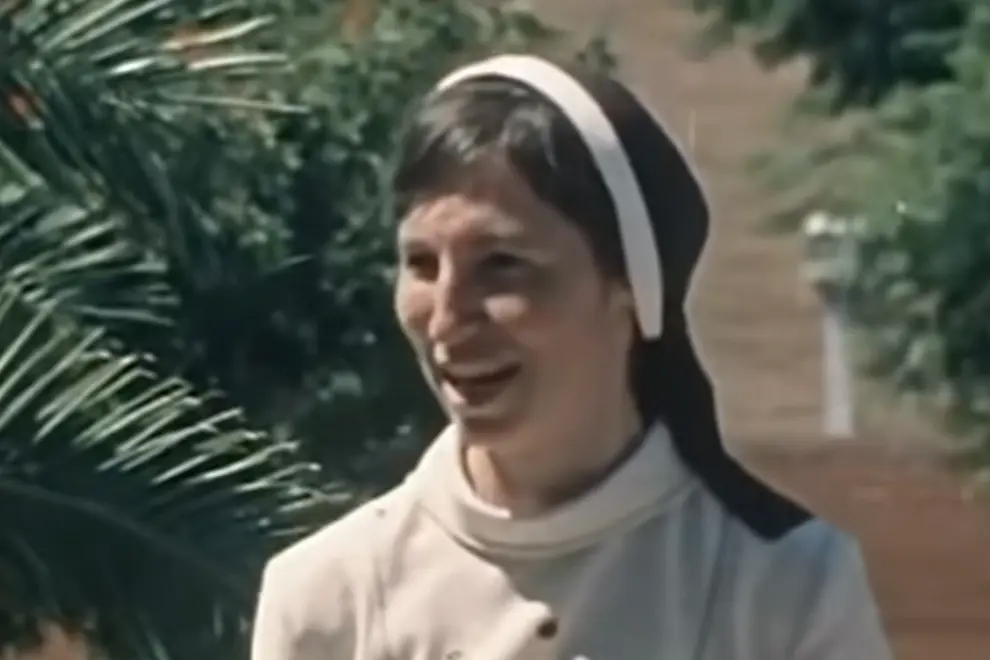It’s a great trivia question:
What was the first song produced in Australia to sell one million copies in the US?
Chances are you’ll guess the Bee Gees or Olivia Newton-John or The Seekers or Helen Reddy. Yep, they all had million-sellers in America – with songs recorded overseas. But the first song recorded in Australia to go platinum in the US was by …
A singing nun.
This is the remarkable story of Sister Janet Mead, a Catholic nun from Adelaide who had one of the biggest pop hits of 1974 – a rock remake of The Lord’s Prayer.
“The whole thing was quite mad,” Sister Janet reflected three decades later. “I only agreed to make a record because I thought we could produce tapes to hand out to people at the Rock Masses.”
Sister Janet was the music teacher at St Aloysius College in Adelaide, where The Lord’s Prayer video was filmed. She’d attended the school as a child, falling in love with music at the age of eight. “What I wanted most in life was to ride a bike and learn to play the piano.” After finishing high school, she studied music at the Adelaide Conservatorium before becoming a Sisters of Mercy nun.
Sister Janet was a pioneer of using contemporary music to enliven the church experience for young people. “I knew we needed to reach them in their own language, which was popular music,” she later explained. Her “Rock Masses” at St Francis Xavier’s Cathedral in Adelaide regularly drew crowds of 2000.
Don't miss a beat with our FREE daily newsletter
Clare Moore – who would later find fame alongside her partner Dave Graney – was one of the drummers in Sister Janet’s band. Playing at the Rock Masses was a formative experience for the young teen.
With people flocking to see Jesus Christ Superstar, Moore remembers a time when “religion and churchy stuff was seen as a bit groovy”. She has a memory of even performing Stairway To Heaven at one Rock Mass. “Which might not have been appropriate,” she laughs. “But Sister Janet was hip to what was going on.”
Moore’s first time in a recording studio was with Sister Janet. And she also attended Sister Janet’s gold record presentation at the Hilton in Adelaide. “It was a very strange but exciting time,” Moore recalls.
In 1999, music journalist Dino Scatena asked Sister Janet if she remembered Clare Moore. “I certainly do,” she replied. “I taught Clare, and I taught her whole family. Her father was very musical and the rest of her family all act. I did hear Clare is very famous. I’m very glad to hear it. That’s very good.”
The popularity of the Rock Mass attracted the attention of Festival Records, who decided to make a single with Sister Janet in 1973. She recorded The Lord’s Prayer at Sydney’s Festival Studios with the label’s in-house producer Martin Erdman. The band rocked up, expecting to be doing a session with actress Abigail, the sultry star of Number 96 who’d just had a Top 10 hit with a version of Serge Gainsbourg’s Je T’Aime.
Instead, the band was greeted by a 35-year-old nun. “They nearly collapsed on the spot,” Sister Janet recalled. “Dear old Martin had a lovely sense of humour.”
Sister Janet recorded two songs – The Lord’s Prayer and a cover of Donovan’s Brother Sun, Sister Moon.
The Lord’s Prayer – with its music composed by young Adelaide musician Arnold Strals, a member of Sister Janet’s congregation – was intended to be the B-side, but it became a smash hit, spending nearly five months on the Australian charts, peaking at #3 in January 1974.
Festival’s boss Alan Hely sent the record to A&M’s president Jerry Moss in the US. And … nothing happened.
And then an A&M promo guy dropped into KMPC, a radio station in Los Angeles. His ears pricked up. “What are you playing?”
“It’s The Lord’s Prayer by this singing nun from Australia,” the music director Alene McKinney revealed. “Every time we play it, the phones light up.”
“That’s our song,” the promo guy said.
“No,” McKinney replied. “It’s on a label called Festival.”
Legendary Australian DJ Bill Gates – who was instrumental in the career of the Bee Gees – had sent the station a copy of the original Australian single.
The promo person raced back to the A&M office on La Brea Avenue and informed his boss: “I think we’ve got a hit record on our hands.”
Another radio station, WJR in Detroit, played The Lord’s Prayer five times in one day and logged the calls to the switchboard: 247 people said it was “beautiful and entertaining”; 76 called it “bad and blasphemous”.
In the last week of February 1974, the three most-added songs to American radio were Blue Swede’s Hooked On A Feeling, Elton John’s Bennie And The Jets and Sister Janet’s The Lord’s Prayer.
The Lord’s Prayer was soon roaring up the US charts, selling 500,000 copies in just 10 days. It would eventually peak at #4 at Easter 1974.
Festival executive Bill Duff remembers the label presented Bill Gates – who was working at Melbourne’s 3UZ at the time – with a gold record to recognise his pivotal role in the song’s American success. The record now sits proudly on the wall at Bill Gates’ home in Surfers Paradise.
The Milwaukee Journal believed a hit movie also contributed to the song’s success. In 1974, the paper wrote that people “are all scared to death from The Exorcist and they’re all running out and buying The Lord’s Prayer”.
Sister Janet was in Rome looking for liturgical music when she found out her song was a hit in the US. “It was just so surreal.”
International chart success was not part of the plan. “I simply sang a prayer I use daily,” Sister Janet told TV Week in April 1974. “I certainly had no idea it would be so successful. When I made the record, I thought that the brothers and sisters would buy it for schools, because that’s what it was meant for.”
Noted critic Clinton Walker believes The Lord’s Prayer is “surely the ultimate Australian novelty song … the only query must be: who gets the royalties for the lyrics? God?”
The Lord’s Prayer – recorded in less than eight hours – sold nearly three million copies worldwide.
Sister Janet – who didn’t even own a record player – gave all of her royalties to the Sisters of Mercy but believes they might not have received all that was due. “I think I was particularly naïve,” she said in a 2015 interview, “and I signed a contract that I didn’t understand.”
With the money they made from The Lord’s Prayer, Festival Records was able to purchase Australia’s first 24-track recording console, so Sister Janet’s impact on Australian music was immense.
Sister Janet was nominated for a Grammy for Best Inspirational Performance, but the award went to Elvis Presley for How Great Thou Art.
Brian Mannix, who was a young Catholic schoolboy in Melbourne at the time, noticed the success of The Lord’s Prayer and realised the power of religious imagery in songs.
“Madonna and Lenny Kravitz have made mentioning God in your lyrics or film clip cool,” the Uncanny X-Men singer later noted. “It seems kind of blasphemous but can’t really be challenged – the song may actually be a sign of dedication. It is an effective tool that may challenge a listener. It has been effectively used by the likes of Nick Cave, Johnny Cash and to some extent Sister Janet Mead.”
Sister Janet admitted she’d never heard of Nick Cave. “The only time I ever listen to the radio is when I’m sick, so I don’t hear any popular music shows or popular music.”
The Lord’s Prayer has been viewed more than one million times on YouTube, not that Sister Janet saw it – she did not own a computer.
In July 1974, Sister Janet released her debut album, With You I Am, which hit #19 in Australia.
Sister Janet’s final album, A Time To Sing, was released in 1999 – 16 years after it was recorded. It included a cover of Pete Seeger’s Turn! Turn! Turn!, which Sister Janet explained was “straight from the Old Testament”.
The album also included a cover of Bob Dylan’s The Times They Are A-Changin’. “I’m a firm believer in protest songs,” Sister Janet said. “I’m a firm believer also in protest. When things aren’t right, we’ve the right to sing about them and to speak about them.”
Sister Janet was actually the second nun to have a hit on the Billboard charts. “The Singing Nun”, Belgium’s Sister Luc Gabrielle, topped the US charts in 1963 with Dominique, preventing The Kingsmen’s version of Louie Louie from hitting number one.
Sister Janet turned her back on a pop career and instead dedicated her life to the Lord, saying she didn’t want to be “side-tracked by the superficial kind of success that I was experiencing”.
Athol Guy asked if she would become The Seekers’ new singer, replacing Judith Durham. She said no. Promoters wanted her to go on tour, including a stint in Las Vegas, but Sister Janet said she didn’t want to become a “novelty nun”.
Pop stardom took its toll, with Sister Janet calling it a “horrible time” as it caused her to question her faith. “I had a very bad time emotionally, a crisis,” she revealed. “I told everyone this wasn’t going to be my profession, that my students came first, and the music world would have to wait.
“I mean, some people need to do this for their living. I didn’t need to, and it was a very, very difficult time for me. It was unexpected, and I was unprepared. It was a complete shock when publicity and notoriety came my way.”
Clare Moore remembers photographers peering over the school fence, trying to get pictures of Sister Janet. “It was all pretty full-on.”
Moore – who has just released a new album with Dave Graney called (strangely) (emotional) – says Sister Janet was an inspiring teacher. At a time when most girls’ schools were offering cooking, knitting and interior decorating as extracurricular classes, Sister Janet was encouraging the girls to get involved in music.
“Before she came along, music class was just a box with a broken tambourine and a singalong, and maybe you also did piano lessons. But she opened it up to everyone and suddenly we were learning guitar and bass and drums.”
Though she would occasionally talk publicly about Indigenous issues, or the rights of homeless people, or campaign against poker machines, Sister Janet enjoyed the fact that most of her media mentions were headed: “Where is she now?”
“I feel like the Scarlet Pimpernel,” she laughed.
In 2004, Sister Janet was named South Australian of the Year – the first woman to receive that honour – in recognition of her work helping the homeless.
Sister Janet remained a member of the Sisters of Mercy but was reluctant to push her faith onto others. “I don’t have a great love for pushing religion as such,” she said in 1993. “People must be given choices.”
Sister Janet is not in the ARIA Hall of Fame but was inducted into the South Australian Music Hall of Fame in 2015.
Sister Janet did a rare interview at the time, telling The Advertiser’s Craig Cook: “I loved making the record, working with terrific musicians, but the experience after that was a total nightmare.”
But she continued to believe in the power of music. “Back in the ’70s, we experienced a time of openness and creativity in all spheres of life,” she said in her induction speech. “In many ways, it’s the opposite now. It seems a terrible blanket of silence has come over us all.
“In the face of the evils of war, greed, inequality and lies, we must sing of truth. When things are not right, we must sing protest songs and voice our protest.”
Sister Janet Mead died of cancer in 2022, aged 84.
Despite shunning the spotlight, our unlikeliest pop star remained proud of the fact her hit single was all Australian. “It was an Australian producer, an Australian record company, an Australian arranger, Australian musicians … everything Australian. So, it was an achievement for all those people, I think.
“If only I’d had the time to enjoy it as much as I could have.”
Only three South Australian women have sold one million records in America – Sister Janet, Orianthi and Sia.
Sister Janet remained grateful for the opportunities a hit record gave her. “In the long run it gave me the possibility to speak for people who don’t otherwise have a voice.”
When she was inducted into the SA Hall of Fame, Sister Janet Mead said:
“We sing not only to change the evils of the world but so they won’t change us.”
















